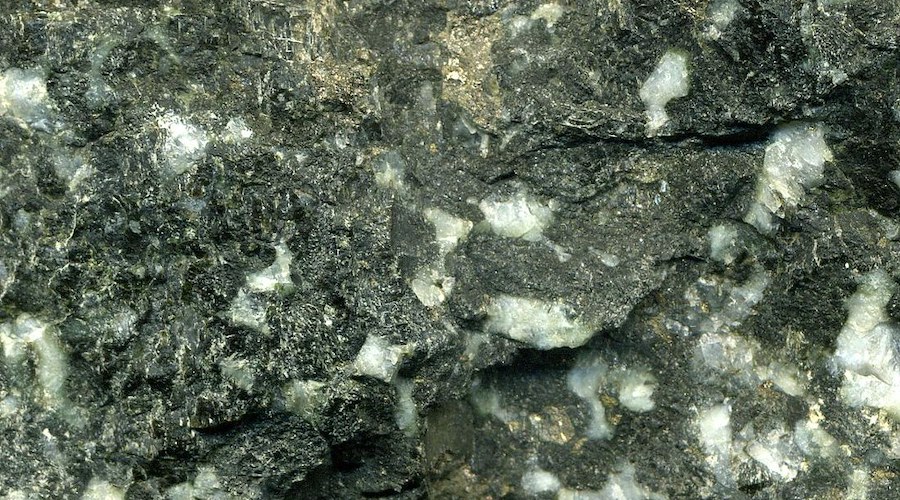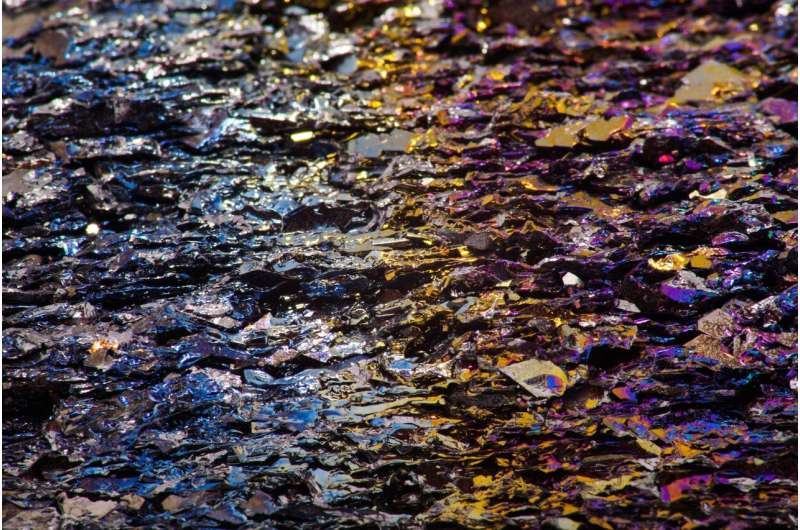MINING.COM Staff Writer | February 1, 2022

Platinum-palladium ore. (Reference image by James St. John, Flickr).
UK and Australia-based researchers have identified the mechanism through which copper, cobalt, tellurium and platinum are passed from the earth’s mantle to the crust.

In a paper published in the journal Nature Communications, the scientists explain that they have discovered a ‘Goldilocks zone’ at the base of our planet’s crust where the temperature is just right at around 1000°C for metals to be transported to shallower levels near the surface, where they can be mined.
The main issue at hand is that most of these metals are primarily stored at depths of more than 25 kilometres, making them inaccessible for exploitation. Yet in certain parts of the world, nature can bring them to the surface through the flow of liquid rock, known as magma, that originates in the earth’s mantle and rises upwards into the crust.
However, up until now the journey of metals to their final deposition site had been uncertain.
The study, thus, clarifies how a temperature-dependent zone, located at the base of the earth’s crust, acts as a valve and intermittently allows the metals to pass upwards to reach the upper crust.
“When magmas reach the base of the crust the critical metals often get trapped here and cannot reach the surface if the temperature is either too hot or too cold,” co-author Iain McDonald said in a media statement. “As with Goldilocks, we have discovered that if the temperature is ‘just right’ at around 1000°C, then metals like copper, gold and tellurium can escape the trap and rise up towards the surface to form ore deposits.”
In McDonald’s view and that of his colleagues, these findings can lead to more targeted, less costly, and more environmentally friendly practices to explore for and extract metals that are key to the manufacturing of renewable energy technologies.
Geologists Uncover 'Goldilocks
Zone' For Precious Metals In
Earth's Crust

Copper is found in sulfide ores such as chalcopyrite and bornite in porphyry deposits.
Leicester research has identified a new 'Goldilocks Zone' in the Earth's crust which could provide metals vital to the green revolution.
The energy future of humankind depends on the continued supply of key metals like gold, copper and tellurium that are essential in the manufacturing of green technology, such as battery storage devices, solar panels and wind turbines.
Now, a new international study led by researchers from the Centre for Sustainable Resource Extraction at the University of Leicester, published today (Monday) in Nature Communications, and funded by the Natural Environment Research Council (NERC), has discovered the presence of a temperature dependent 'valve' located at the base of the Earth's crust, which intermittently allows these important metals to pass upwards to shallower levels.
Critical metals required to enhance the green energy revolution are largely stored in the mantle of our planet, at depths in excess of multiple tens of kilometres that are inaccessible to direct extraction.
Fortunately, every now and then, nature does most of the hard work for us. Magmas sourced from within the Earth's mantle rise up into the crust and have the potential to carry, and then concentrate and deposit, large volumes of metals.
Dr David Holwell is an Associate Professor in Applied and Environmental Geology and lead author for the study. He said:
"When magmas reach the base of the crust, the conditions there act like a 'Goldilocks Zone' for these metals. If the temperature is either too hot or too cold, these 'valves' remain shut and metals cannot pass through, but we have found that in many cases, it may be 'just right' at around 1,000°C, where metals like copper, gold and tellurium can be released."
This finding sheds light on the planetary cycle of metals and how some of the world's largest resources of copper are formed. The work is part of the NERC-funded FAMOS project (From Arc Magmas to Ores), and involved collaborators from Cardiff University, the University of Western Australia and the mining company BHP.
Professor Jamie Wilkinson, of the Natural History Museum, London, is Principal Investigator for the FAMOS project, and added:
"This paper represents a fantastic piece of work from the project team that sheds new light on magmatic processes that operate deep in the Earth's crust but which have major implications for the accessibility of critical metals for humankind. The results will enable more targeted mineral exploration, thus lowering the environmental footprint associated with the discovery and extraction of green metals."
'Mobilisation of deep crustal sulfide melts as a first order control on upper lithospheric metallogeny' is published in Nature Communications.
Scientists identify geological 'Goldilocks zone' for the formation of metal ore deposits

Scientists have identified a mechanism through which important metals, crucial to the manufacturing of renewable energy technologies, are passed from the Earth's mantle to the crust.
The team, including researchers from Cardiff University, has discovered a 'Goldilocks zone' at the base of the Earth's crust where the temperate is just right at around 1000°C for metals to be transported to shallower levels near the surface, where they can be mined.
The metals in question—most notably copper, cobalt, tellurium and platinum—are highly-sought after due to their use in electrical wiring and technologies such as battery storage devices, solar panels and fuel cells.
Publishing their findings today in the journal Nature Communications, the team is hopeful that the results can lead to more targeted, less costly, and more environmentally friendly practices to explore for and extract the key metals.
The metals are primarily stored in the Earth's mantle—a thick layer of rock that sits between the Earth's core and crust—at depths of more than 25km, making them inaccessible for exploitation.
Yet in certain parts of the world, nature can bring these metals to the surface through the flow of liquid rock, known as magma, that originates in the Earth's mantle and rises upwards into the crust.
However, up until now the journey of metals to their final deposition site has been uncertain.
In the new study, the team identified a temperature dependant zone, located at the base of the Earth's crust, which acts like a valve and intermittently allows the metals to pass upwards to reach the upper crust.
Co-author of the study Dr. Iain McDonald said: "When magmas reach the base of the crust the critical metals often get trapped here and cannot reach the surface if the temperature is either too hot or too cold.
"As with Goldilocks, we have discovered that if the temperature is 'just right' at around 1000°C, then metals like copper, gold and tellurium can escape the trap and rise up towards the surface to form ore deposits."
The study forms a component of the NERC-funded FAMOS project (From Arc Magmas to Ore Systems), and involved collaborators from Cardiff University, Leicester University, the University of Western Australia and the international mining company BHP.
Professor Jamie Wilkinson, of the Natural History Museum, London, is Principal Investigator for the FAMOS project, and added: "This paper represents a fantastic piece of work from the project team that sheds new light on magmatic processes that operate deep in the Earth's crust but which exert a first-order control on the accessibility of critical metals for humankind. The results will enable more targeted mineral exploration, thus lowering the environmental footprint associated with the discovery and extraction of green metals."
New tools to unearth rare metals
Journal information: Nature Communications
Provided by Cardiff University
No comments:
Post a Comment